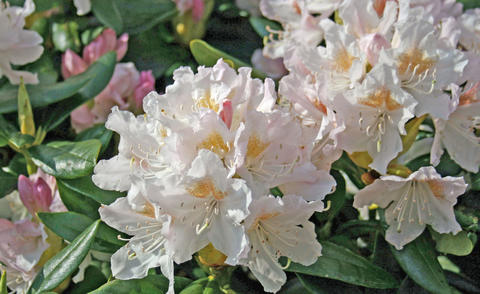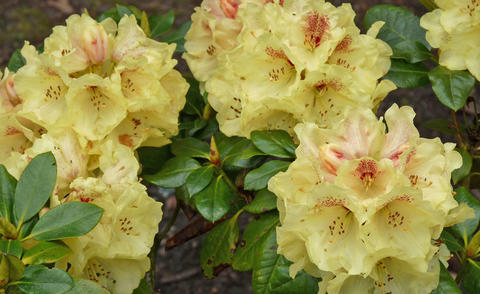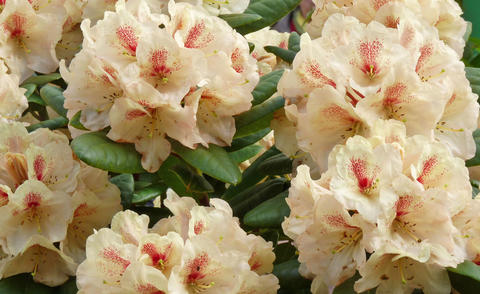Recommended Rhododendron Varieties
Rhododendron flowers are one of the highlights of the gardening year. Here you will find a large selection of Rhododendron varieties recommended for your garden.

The pink flowers of the Rhododendron hybrid ‘Kokardia’ open between May and June, they have a blackberry colored blotch on the inside
Rhododendron varieties exhibit a color palette that is unrivaled in the plant kingdom. Intensive breeding is constantly creating new varieties, some of which have several colors. Breeders not only attach importance to a stunning floral spectacle – beautiful foliage, compact growth and very hardy plants are also important breeding goals. The new varieties of Rhododendron can also cope with less than ideal soils and locations. Below, we present our recommended Rhododendron varieties.
Recommended Rhododendron varieties at a glance
- Large-flowered Rhododendron hybrids: ‘Cunningham’s White’, ‘Catawbiense Grandiflorum’, ‘Mendosina’, ‘Kabarett’, ‘Goldinetta’, ‘Kokardia’
- Rhododendron Yakushimanum hybrids: ‘Barbarella’
- Rhododendron Wardii hybrids: ‘Blueshine Girl’
- Rhododendron Forrestii hybrids: ‘Scarlet Wonder’
- Rhododendron Impeditum ‘Azurika’, ‘Moerheim’, ‘Ramapo’
- Rhododendron russatum ‘Compactum’
Large-flowered Rhododendron hybrids have been found in gardens and parks for more than 200 years. Older varieties such as ‘Cunningham’s White’ and ‘Catawbiense Grandiflorum’ are large, fast-growing flowering shrubs that thrive under trees that allow light to filter through such as pines and oaks. However, these old varieties are only of limited suitability for smaller gardens and less favorable soil conditions: they not only grow tall, but also very wide, can only tolerate a little more sun in moist soil and can be quite frost-sensitive depending on the variety.

Following the trend for old varieties is therefore not advisable for most Rhododendrons – in contrast: new varieties are healthier, more compact, more adaptable and more frost resistant. ‘Mendosina’ is one of these new Rhododendron varieties: with its bright ruby-red flowers and black-red blotch on the upper petal, it adds to the range a color variation that had previously not existed. The multi-prize winning new variety has a compact growth habit, dark green foliage and is around 51 inches high and 59 inches wide after ten years.
‘Goldinetta’ is a free-flowering, pale yellow new variety. The yellow color, which is quite rare for large-flowered rhododendron hybrids, becomes more intense towards the center of the flower and is a striking contrast to the dark green, glossy leaves. The plant grows relatively weakly and reaches a height of around 43 inches and a width of around 51 inches after ten years. It is frost-hardy to around -11 degrees Fahrenheit in areas of partial shade.
‘Kokardia’ grows broad and upright into an approximately 47-inch tall and 55-inch wide shrub. The flowers appear ruby pink when they bloom in May, they later become lighter. They have a large blackberry colored blotch on the inside and white stamens.
A wild species called Rhododendron Yakushimanum grows to a height of between 3280 and 6234 feet on the small Japanese island of Yakushima. It now plays a key role in modern Rhododendron breeding. In recent years, the Yakushimanum hybrids have been bred based on the exceptional talents of this Asian mountain dweller. This has produced many top quality rhododendron varieties with excellent suitability for gardens. They have all inherited the low, compact growth habit of their ancestor, as well as its profuse blooming and sun tolerance.
The "Yakus", as they are affectionately known among connoisseurs, are typically characterized by their coarse, robust foliage which is densely covered with silvery, felt-like hair especially when young. This hair is not only extremely decorative, but also protects the foliage against the elements in locations that are exposed to the wind and sun – just like in its natural habitat. The flat growth of many varieties makes it suitable for all kinds of stones and it also comes into its own on garden slopes.
‘Barbarella’ is a modern breed with a mesmerizing play of colors in orange, yellow, red and pink. It grows very slowly – it reaches a height of around 14 inches and a width of approximately 24 inches after ten years – and its flowers open around mid-May. The variety has rather small flowers and leaves for a Yakushimanum hybrid, but is extremely free flowering.

The Rhododendron variety ‘Goldprinz’ lives up to its name. The intense golden-yellow flowers with slightly ruffled petals have delicate, dark speckled spots on the inside and open around mid-May. After ten years, the variety is around 28 inches tall and 35 inches wide. Light protection with a shade cloth or fleece is advisable during harsh winters.
‘Karminkissen’ is an extremely bright and free-flowering variety. The crimson flowers sit very close to each other during the main flowering season in mid-May, making the plant look like a bright red cushion from a distance. After ten years, the height and width are around 16 and 28 inches respectively.
The wild species Rhododendron wardii is primarily used to breed yellow-flowering Rhododendron varieties. The color spectrum of the Rhododendron wardii hybrids now ranges from cream white to pale yellow and apricot. Many shrubs begin flowering in late April, their growth is very compact and is slow to moderate. A semi-shaded location, which is protected from the wind and winter sun, is usually recommended.
The bell-shaped, cream white flowers of ‘Blueshine Girl’ have a pale yellow tone and a small red basal spot. The shoots and leaf stalks initially appear purple violet. After ten years, the Rhododendron variety reaches a height of around 47 inches and a width of approximately 55 inches.

‘Goldbukett’ is compact and grows into a 35-inch tall and 47-inch wide shrub. In May, the flowers are arranged in dense spherical trusses. They appear as copper-colored buds and have a creamy yellow glow once they have flowered. The outsides have a light pink tone, the insides have a light red spot and a vibrant dark red marking.
Compact growth and bright red flowers were reason enough for breeding Rhododendron Forrestii. The first Rhododendron varieties appeared in Great Britain after 1930. Rhododendron Forrestii hybrids are characterized by low, compact growth and bell-shaped scarlet or bright red flowers. They also thrive in sunny spots provided that the soil is very moist. A word of caution: if the flowers appear from mid-April, they can be susceptible to late frost.
‘Baden-Baden’ grows into a small, semi-spherical shrub that forms scarlet flowers with a faint dark brown marking in May. The bell-shaped flowers overhang slightly and have a wavy edge. After ten years, this Rhododendron variety will be around 35 inches high and 55 inches wide.

The ‘Rotkäppchen’ (Little Red Riding Hood) variety has its name for a good reason: the shrub is covered with an abundance of red flowers that glow a vivid red in May. It has cushion-shaped and very dense growth; this Rhododendron variety will be around 16 inches high and 28 inches wide after ten years. The deep green leaves provide a nice contrast to the flowers.
The flowers of the ‘Scarlet Wonder’ are a bright scarlet red with faint brown markings. The flower buds turn brown-red in winter. You can expect a height of 28 inches and a width of 43 inches after ten years.
Rhododendron Williamsianum has an unmistakable character, which is easily seen in the hybrids too. The species is native to the Chinese provinces of Sichuan and Guizhou and is characterized by dense, semi-spherical growth, intensely bronze leaves when young and loose inflorescences. Crossing with large-flowered hybrids has produced both high and low growing Rhododendron varieties. The Rhododendron Williamsianum hybrids are more robust than the species itself, but a sheltered spot is still advisable.

‘Gartendirektor Glocker’ has a flattened semi-spherical growth habit and stays nicely compact. After ten years, the variety is around 35 inches tall and 47 inches wide. The small leaves have an intense bronze color when young. It blooms with an abundance of rose red flowers in May and later a dark red spotting.
The Rhododendron variety ‘Gartendirektor Rieger’ grows broad and upright and reaches an approximate height of 55 inches and a width of 67 inches. The strong leaves are a glossy green. The cream flowers, which open in May, have a distinct dark red spotting and a pink tinge on the outside.
‘Vater Böhlje’ charms in May with its delicate purple-pink flowers with a slightly wavy edge. It has a regular semi-spherical, compact growth habit. The Rhododendron williamsianum hybrid is around 28 inches high and 35 inches wide after ten years.
Rhododendron Impeditum and its varieties are perfect for anyone looking for a Rhododendron with purple flowers. The violet Rhododendron is sometimes called a cushion Rhododendron because of its cushion-shaped growth habit. The evergreen dwarf shrubs do not generally grow taller than 3.2 feet and are suitable for stone gardens and heather gardens.

‘Azurika’ develops deep violet-blue flowers. This multi-award winning Rhododendron variety grows to between 16 and 24 inches tall and 28 to 35 inches wide. ‘Moerheim’ is an old, well-known variety of Rhododendron Impeditum. It has a light purple bloom and grows to a height of around 16 inches and a width of 31 inches. Rhododendron Impeditum ‘Ramapo’ stands out as an exceptionally hardy hybrid. The flowers of this tough variety have a mauve to light purple-pink color. It grows to a height of 24 to 31 inches.
Rhododendron Russatum is a hardy, extremely free-flowering species for alpine gardens, heather gardens and small flowerbeds, however it needs evenly moist soil. There are now several recommended Rhododendron varieties on the retail market with a flower color that varies from a deep violet blue to an almost pure blue. The free-flowering variety ‘Azurwolke’ is a deep violet blue and grows to a height of around 31 inches. The name says it all about the ‘Compactum’: this Rhododendron variety is wonderfully compact and grows into a 12 to 16-inch tall and 20 to 28-inch wide shrub. Its violet blue flowers appear from the end of April. Locations that are out of direct sunlight or partially shaded are favorable.
The quality of these new Rhododendron varieties is not least due to the higher tolerance of the roots to unfavorable soil conditions. However, this is not down to the variety itself, but rather the rootstock. At the end of the 80s, several Rhododendron nurseries came together to form a community for the breeding of lime-tolerant Rhododendron rootstocks, known as Inkarho. It set itself the goal of breeding a special rootstock, in a similar way to fruit trees, which was supposed to be more lime tolerant and compact than the ‘Cunningham’s White’ variety, which was commonly used as a rootstock.
The goal was achieved in the early 90s after several years of breeding work. All Rhododendron varieties that are grafted onto this new rootstock during breeding instead of using ‘Cunningham’s White’ cuttings are sold as Inkarho Rhododendrons. They are a little more expensive but the investment pays off, especially in areas with heavy, calcareous clay soils. Despite the increased soil tolerance, you should not expect miracles: you cannot completely avoid soil improvement, in other words, thoroughly loosening the soil and enriching it with humus.

